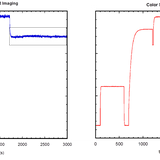Contact:
Contact us at:
info@spring-systems.se
phone: +46 708 298484
FAQ
Question:
Why is the noise much lower in your system?
Answer:
The technique has numerous advantages that are multiplied, which increase the signal to noise ratio, SNR, significantly, i.e. you get a much lower noise level. We talk of factors and orders of magnitude, not percentage.
SNR = A x B x C x D x E x F x G
A: We are using many wavelengths. More wavelengths means more information channels, which means less noise
B: We use both the positive and the negative slope of the SPR-dip in a differential way, which means that the effective slope is amplified by a factor two.
C: We use only the parts of the SPR-dip were the sensitivity is highest with respect to the resonance condition.
D: We use a true imaging technique, which means that we do not “smear out” resonance conditions which are common in ordinary systems. Other systems typically get a superposition of SPR-dips, which leads lower sensitivity due to more shallow SPR-dips and less steep flank slopes.
E: We measure the whole sample area and get maximum sensitivity over the whole area, due to the fact we do not superimpose SPR-dips with different resonance conditions. This is not possible in ordinary systems.
F: We can zoom in a sample spot to enhance the sensitivity. More pixel channels are involved. The pixel number increases as the square of the amplification, which reduce noise much more effectively than for ordinary systems. Where traditional systems reduce the noise as a factor SQRT(X), we reduce the noise with a factor X, where X is the amplification for each sample spot. Instead of using 200 x 200 spots, but using 4 spots lead to a 100 fold reduction in noise. Measuring spots can have arbitrary shape.
G: We can apply a very effective noise reduction, which is not possible in angle or wavelength resolved systems.
Question:
Why is your instrumental drift much lower than others?
Answer:
We do differential measurements, which mean that we cancel drifts and offsets.
Question:
How can you get true response signals during uneven surface concentration, e.g. during initial binding?
Answer:
We measure the true surface concentration over the entire sample spot. No optical averaging or “smearing”, which is typical for traditional angle resolved instruments. If there should be an uneven surface concentration within a pixel, the differential measurement ensures that there will be a true averaging over the pixel. For traditional SPR-imaging there will be an erroneous signal due to SPR-dip “lifting”.
Question:
How do you get maximum sensitivity for uneven surface concentration, e.g. during initial binding?
Answer:
We measure the true surface concentration at each point and get steep SPR-dips. We can use an uneven surface concentration to get a true interpretation what is going on. This is not possible in ordinary SPR-systems.
Question:
How fast can you measure?
Answer:
We can measure at very high frame rates, 100 000 Hz or even 1 000 000 Hz is not a problem. Yes, frame rates, the whole picture of the surface concentration. However, normally a much lower frame rate is used. There is no lower limit.
Question:
How many spots can you measure?
Answer:
You decide: from 1 to 100 000 is no problem. With few sample spots you get less noise. You do not have to change anything to change the number of sample spots. This is the most versatile technique available.
Question:
Must the measuring spots be square?
Answer:
No, the sample spots can have an arbitrary shape.
Question:
How can you have such a big dynamic range?
Answer:
We use many wavelengths and therefore we can cover a large dynamic range, something that is not possible with traditional instruments.
Question:
Are there any drawbacks?
Answer:
No, this is a system that you can use as the fastest, with most sample spots, with the highest sensitivity, linearity and dynamic range, without changing the system. However, there will always be a tradeoff between speed and noise.
SPR Imaging -
The next generation of SPR with high sensitivity in combination with high performance and productivity.
.
